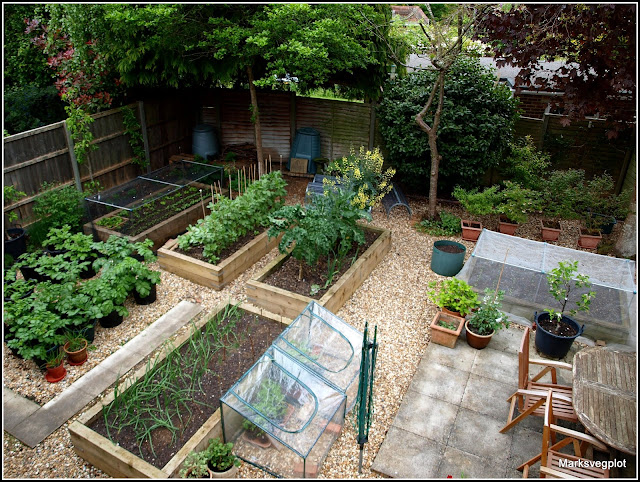 |
| May 2017 |
Anticipation and forward-planning is key. All too often I read about people forgetting to sow seeds at the right time, and leaving it too late. There are ways to avoid this: why not arrange your seeds in a box in sowing-date order, so that you know what is next to go in? Or if you're into the technology, you could set up a diary reminder in Outlook or a similar email programme on your computer or phone? In my case, I rely mainly on my feel for what is right, based on my 30+ years of gardening experience!
The other day I harvested my onions, and as I said at the time, I took them up perhaps a bit earlier than I should have done for best results, but I was conscious that if I didn't get some Chicory and Endive plants in the ground soon then I wouldn't have any of them ready until very late in the autumn, at which time they would probably succumb to frost. This is the half-bed that was released by lifting the onions:
And here it is 24 hours later:
You can see that I have already begun to re-populate it. The little plants are six lettuces and six radicchio. More will follow very soon. In ideal circumstances it would have been good to add some home-made compost to re-invigorate the soil, but I didn't have any available (having used it all in the Spring), so I had to make do with a few handfuls of pelleted chicken manure. After planting the lettuce and radicchio I watered them in very thoroughly because the soil was very dry. This bed is also quite sandy because I have previously added sand in order to grow carrots in it. I find that as long as I keep adding at least one good dose of compost every year I can cultivate my raised beds more or less constantly if I want.
 |
| Leeks at the back, then lettuce, then radicchio |
You will have noted that I planted not only radicchio but also lettuce. This is because I know that the lettuce will mature much more quickly and will be harvested and out of the way well before the radicchio reaches maturity. In a few days time I will add another row of lettuce between the radicchio and the endives that are due to go in next - for the same reason.
Back to the Project Management theme... In order to maximise the use of space, I tend to grow many of my vegetables initially in seed-trays, pots or modules rather than direct sowing them into their final positions. This means that one crop can be occupying a raised bed while another is kept "waiting in the wings" until the space becomes vacant. For instance, carrots sown in March can normally be lifted in July or August and replaced with module-grown cabbage plants that will grow slowly over the Winter, maturing in the spring. This method needs careful time-management too, because plants kept too long in small containers often become root-bound, or bolt. At best they will be stunted. Here's an example:-
Those are spare PSB plants, kept as reserves in case of casualties in the main crop. I have kept them and kept them "just in case", but you can see that they are now dull, pale and weak because they have exhausted nearly all the nutrients in their little pots. Sadly, they are never going to get planted, though if they were planted in the next few days they would probably still be OK. [By the way, I have already given away some of my other spare PSB plants, so they have not all been wasted.]. Compare them with the main-crop plants (their exact contemporaries in terms of sowing) which went into the ground at just the right time in the first week of July:
As they say "Timing is everything"!






And it's not just with vegetables! Last year I decided that, rather than leaving the beds in which I plant summer bedding to lie fallow through the winter, I would grow a range of winter/spring bedding. And come the autumn, I had a couple of hundred plants in the greenhouse waiting to go in the ground. But the summer bedding was still flowering its socks off. I ended up having to lift lots of still perfectly good plants rather than transfer my winter bedding straight to the compost bins. It was a no-win situation really. Which I faced again this year when the summer stuff needed to replace the still flowering and covered in bud winter stuff.
ReplyDeleteHmmm, that is awkward, John. Maybe you just need a bigger plot!
DeleteDespite us having more space the same is true for us. It's a bit like the fact that no matter how many cupboards you have they will be filled.
ReplyDeleteSo true! "Stuff" expands to fit the space available.
Delete